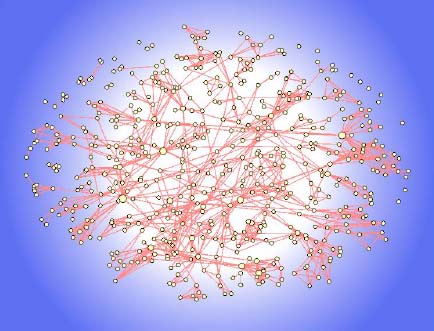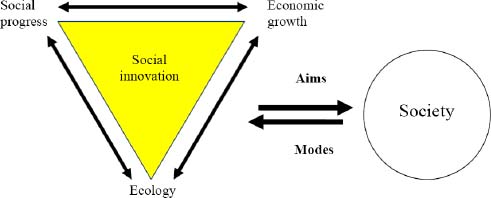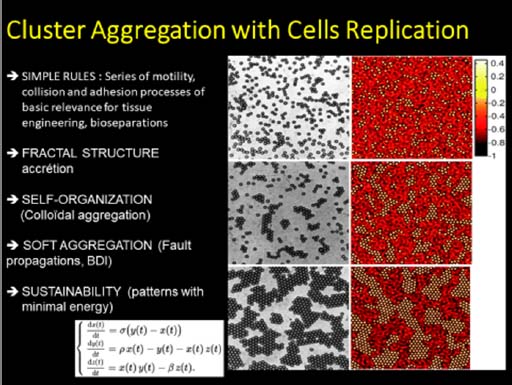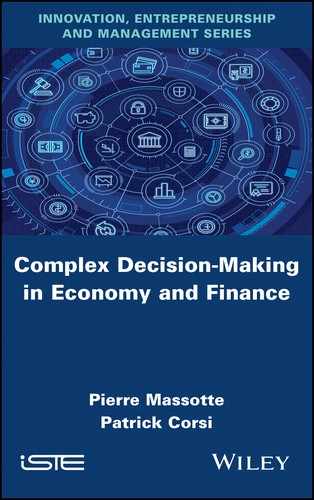12
Physics and Social Networks: Domain Similarities
12.1. Introducing a similarity of domains
The objective of this chapter is to establish a similarity link between the behavior we have in banking and in Nature. For that purpose, we will mention the social trouble France faced with the “Yellow Vests” phenomenon and the mode of governance in the country. More generally, this highlights a problem of adaptation, quite common with what exists in Nature.
Presently, the “behavioral economy” is a strong and dynamical trend in Economy. It was developed thanks to the contribution of Richard H. Thaler (2017 Nobel Prize): he focused on scientific studies related to cognitive bias that impacts the rationality of the homo œconomicus. Indeed, following the results of Amos Tversky and Daniel Kahneman (2002 Nobel Prize), these experts in psychology and behavioral economy focus on some deviances specific to conventional and rational approaches in economy.
Here, we focus on the fact that decision-making in economy is much more dependent on much more subtle agents and factors than the approaches based on excessive mathematization.
As stated by Adam Smith (The Wealth of Nations, published in 1776), the theory of “moral feelings”, in which any individual being appears as a more complex being than a simple rational agent, cannot be anymore ignored since we know that our mental pre-disposition is of key importance in any decision process.
Today, this explains why, when faced with “social networks”, the mode of conventional governance must be challenged and adapted to the new societal environment. Within this context, we will first remind two main statements associated with these facts, which characterize any organization:
- 1) “Any aversion to the loss of power (or asset, etc.) contributes to generate a kind of inertia characterized by the need or willing to preserve one’s acquired assets”.
- 2) As stated by Bill Gates, in 1994, “Banking is necessary, but banks are not”. These observations can be easily explained by the following explanation of behavior and physical characteristics specific and quite common in Nature.
12.1.1. Problems of complexity and connectivity
A very important notion is related to the concept of network. As said in [MAS 13], everything in Nature is interacting; whether it is in matter, life, industry, economy, etc.
The interactions existing in a network are of key importance to understand the behavioral complexity of a system. The level of complexity is itself depending of the connectivity of the graph: as explained in [MAS 15b], the best configuration is gained with a low connectivity (number of interactions for each node is about 3/4).
Hereafter, we can consider the network of interactions involved either in a social network such as Facebook or Wechat (which is a Chinese web application that fulfills and integrates several functions similar to WhatsApp, Facebook, Twitter and Tinder, as well as carries electronic wallet capabilities, e-commerce functions, cab management, etc.), or in a worldwide distributed manufacturing center. All these web applications can be considered as holonic systems, as shown below.
Since such networks are difficult to manage and control, we can proceed to its simplexification (here, we remind that simplexification is not similar to simplification [MAS 17b]). It consists of reducing the K-connectivity through the study of the nearest neighbors.

Figure 12.1. Example of a physical/fractal organization. For a color version of this figure, see www.iste.co.uk/massotte/complex.zip

Figure 12.2. Reduced complexity through simulation analysis and complex graph theory. For a color version of this figure, see www.iste.co.uk/massotte/complex.zip
In the above simplexified graph, we can state that the granularity, then the autonomy level of the graph, is changed. Such architecture is the one encountered in advanced manufacturing systems and/or in finance. This is the reason why Bill Gates declared in 1994 that “Banking is necessary but banks are not”: the way to conduct banking and the architecture of their associated production resources – the infrastructural underpinning – are quite different.
12.2. On the principle of emergence
One more characteristic of the social network is due to the fact that many people, on a peer-to-peer mechanism, are exchanging multiple information on a real-time basis. Between each information exchange (as for in a team working organization), maturation mechanisms occur and enable either the amplification of creation of ideas and concepts.
Most importantly, in terms of application, is the pack effect which is the result of the frenzy of ideas and people’s engagement to have similar generalized behaviors? It may lead a whole population to progressively dismiss and condemn any wrongdoing. This process is called “social innovation”. Since the network includes feedback loops and nonlinear transformations, it is able to generate new and unexpected ideas that conduct to specific attractors. This is called an “emergence”: neither the network future can be predicted nor its convergence towards a steady state. We are in a pull strategy!
This evolution coming from the emergence of a concept (issued at the element level) from up to its stabilization to a global attractor cannot be predicted or controlled.
Also, these principles may be extended to any field of application as detailed in Figure 12.3.

Figure 12.3. Evolution of social innovation and emergence in any field of application
All the above mechanisms and characteristics were detailed in [MAS 17b] and surely apply to banking operations: for defining either the new needs of a customer and/or the mode of operations in finance. It is not a top-down organization since the cultural goal is centered to the demand issued from the basic elements of an organization.
Now, in the following, we can explain how the emergence appears in any complex model or organization. In Nature, everything we consider depends on physical laws, which is a major characteristic of self-organization. Also, self-organization is always governed by the notion of energy, which has to do with the theory of thermodynamics. As a result, any evolution in Nature and any adaptation require an “energy”-oriented transformation, according to the second law of thermodynamics.
In the following chart, we detail how aggregates are generated and how they grow, to progressively give self-organized assemblies, with a specific pattern. The energy of a final pattern is an equilibrium of all the constraints applied to the system; its energy is a minimal one, in the sense of thermodynamics, and provides a “best for fit” stability.

Whatever the domain of applications: banking, industry, gaming, economy, etc., the final pattern can be expressed as a concept, a BDI (Belief, Desire, Intent) or a need for a given product, etc
As we can see in the above figure, it is impossible to predict where and how the pattern will evolve: the nonlinear interactions of the systems are characterized by many possible trajectories rapidly diverging. Therefore, when faced with the phenomenon of emergence, the only strategy consists of adapting ourselves to the evolution around us (in order to be reactive!) to increase the horizon of control (semi-predictive in anticipative strategy) through the simplexification of the system.
In any case, the solution can be intricated to a pre-imposed approach since self-organization applies. Everything starts with organization and ends with organization!
12.3. Finance, economics and physics: the quantification of emergence
12.3.1. Emergence and complexity
This section is aimed at determining the relationships between finance, economics and physics. One advantage of this approach is to enable the modeling of emergence mechanisms, then to measure the level of its importance and to understand why the economic events cannot be predicted but instead anticipated.
It is often thought that complex systems are a separate category of systems to simple systems. So, what is it that distinguishes a complex system, such as a living organism, or an economy, from a simple system, such as a pair of pliers? This question is related to the famous question of What is Life? What is Industry? What are the relations between banking and Nature? By observing how Nature is functioning, however, we may have simple answers; even though not all complex systems are living or even associated with living systems.
As already defined, complex systems comprise a lot of interconnected elements through nonlinear or dynamical relationships. Such definition of complexity is underpinned by physical properties closely related to Kolmogorov’s notion of complexity and Shannon’s entropy measures. They are widely used complexity measures, yet address a number of concerns against them. Similarly, as usual in industry [MAS 17b], we use Lyapunov exponents.
The interpretation of the complexity level, however, is not convenient. Another way of doing this is to introduce context dependence into the definition of complexity. Here, we consider inherent properties of complexity, such as entropy and emergence.
12.3.2. Complexity as a quality – self-organization and emergence
Let us consider the concept of emergence [FRO 04], as described before. We intuitively recognize emergence as patterns arising out of the interactions of the components in a system, but not implicit in the components themselves.
In fact, by emergence, we mean a Stochastic Growth from the Bottom Up, among the elements of an interconnected network. It consists of developing aggregated cells, through self-organized mechanisms as soon as there exist strong links between the adjacent neighborhood according to a random probability.
Examples include the formation of hurricanes from pressure gradients in the atmosphere, crashes in stock markets, flocking behavior of many types of animals and, of course, assembly process in industry, life itself. The issue is to know how we can measure the importance of an emergence.
12.3.3. Emergence and thermodynamics: a general view
In the field of emergence, the way the aggregations are conducted is dependent on the main thermodynamics principles. Indeed, emergence is strongly linked to complexity and self-organization capabilities: thermodynamics gives a macroscopic description of material systems, expressed in terms of temperature, pressure and entropy. It is related to the microscopic description and properties of molecular dynamics models via the reductionism theory leading to statistical mechanics.
Within the classical thermodynamics framework, entropy (S) was developed in the early 1850s by Rudolf Clausius: it describes how to measure the entropy of an isolated system in thermodynamic equilibrium with its parts. Indeed, in a Carnot cycle, a given quantity of heat QH is absorbed isothermally at temperature TH from a “hot” reservoir is given up isothermally as heat QC to a “cold” reservoir at TC.
Thus, entropy is a relationship (characterizing the Carnot cycle) expressed in increments of entropy (∆), equal to the ratio of incremental heat transfer divided by temperature:
This above quantity is objectively defined, up to an additive constant (usually assumed to be such that entropy vanishes at absolute temperature/zero). Thus, entropy “S” is found to be a function of state, specifically a thermodynamic state of the system. Here, entropy is linked to temperature, the same as volume is related to pressure.
Returning to finance, banking and economy (as for information theory), we can say that entropy is an expression of the disorder, the randomness of a system or the lack of information about it.
Concerning the phenomenon of emergence, and statistical mechanics, entropy in a microcanonical ensemble is given by the Boltzmann formula as follows:
In this formula, KbkB is the Boltzmann constant (giving entropy in units of Joules per Kelvin) and “W” is the number of random microstates, accessible to the system for a particular macroassembly, also called macrostestate assembly (emergence ➔ aggregation). Here, the entropy “S” is related to the amount of additional information needed to specify the exact physical state of a system, given its macroscopic specification. This formula is quite similar to the information-based complexity formula: as expressed by [JAY 65], entropy “measures our degree of ignorance as to the unknown microstate”.
Nevertheless, as a result [MAS 08b], the macroscopic (thermodynamic) description of a system is time irreversible, whereas the microscopic description is reversible. Hence, we always focus on the fact that it is impossible to explain how the properties of micro-level system cannot be extended and are not able to explain the properties at the meso-level of macro-level assemblies.
12.3.4. A few applications
Let us consider a couple of simple illustrative examples, which are well known and understood.
First example: the ideal gas
Second example: the Game of Life
The well-known Game of Life was introduced by John Conway in 1982. This is a cellular automaton [citation from J. Conway in WOL 82], in this case, a 2D grid of cells where each cell can be one of two states. The system dynamics is imposed by the rule that the state of a cell depends on the values of its immediate neighbors at the previous time step.
Upon running the Game of Life, one immediately recognizes a huge bestiary of emergent objects, such as blocks, blinkers and gliders. Take gliders, for example. This is a pattern that moves diagonally through the grid. The human observer recognizes this pattern and can use it to predict the behavior of the system with less effort than simulating the full cellular automaton. It is a model of the system. However, the concept of a glider is not entailed by the cellular automaton specification, which contains only states and transition rules. It requires the additional identification of a pattern by the observer.
This leads to a general formulation of emergence [STA 01]. Consider a system specified in a language L1, which can be called the specification, or syntactic layer (see Figure 12.2). If one accepts the principle of reduction, all systems can ultimately be specified the common language of the theoretical physics of elementary particles. However, an often-believed corollary of reduction is that this specification encodes all there is to know about the system. The above two examples show this corollary to be manifestly false. Many systems exhibit one or more good models, in another language L2, which can be called the semantic layer.
The system’s specification does not completely entail the behavior of the semantic model, since the latter also depends on specific identifications made by the observer. In such a case, we say that the properties of the semantic model are emergent with respect to the syntactic specification.
12.4. About Gödel theorems
In our previous two examples, neither the thermodynamic model nor the glider model can be said to perfectly capture the correct behavior of the system. Indeed, since half a century ago, we know that the evolution of a system is limited by two problems (or theorems) of mathematical logic: the incompleteness and consistency problems.
They are part of Gödel’s incompleteness theorems, published by Kurt Gödel in 1931. These theorems are widely, but not universally, interpreted as follows:
- – The first incompleteness theorem states that no consistent system of axioms whose theorems can be listed by an effective procedure (such as an algorithm) is capable of proving all truths about the arithmetic of the natural numbers. It is a limitation: in any consistent formal system, there will always be statements about natural numbers that are true, but that are unprovable within the system.
- – The second incompleteness theorem is an extension of the first, and shows that the system cannot demonstrate its own consistency.
In other words, the more a system evolves, the more it digs its own grave. Finance, economy and banking are evolving like a formal system. Thus, they will surely reach a limitation if any inconsistency or incompleteness. For example, the second law of thermodynamics only holds in thermodynamics. A limitation is that entropy may occasionally decrease within finite sized systems. By cons, a model based on gliders cannot predict what happens when two gliders collide. However, in both cases, the semantic model is cheap to evaluate, relatively to simulating the full system specification, which makes the model attractive: “good” or “useful” to the observer.
We do not prescribe here exactly how to generate good models except for simple study cases: in all cases of emergence, the observer has defined a least one semantic and/or one syntactic model of the system, and that these models are fundamentally incommensurate since they are leading to complexity theory. Moreover, we implicitly cannot assume that all models must be perfect (i.e. in perfect correspondence with the underlying system).
Gödel’s incompleteness theorems were the first of several closely related theorems on the limitations of formal systems. They can apply everywhere and to everything; even in artificial intelligence systems or with Internet of Things technologies. They, however, can be completed with Turing’s theorem dating from 1936 which proved that there is no algorithm to solve the halting problem: determining, from a description of an arbitrary computer program and a given input, whether the program will finish running (i.e. halt) or continue to run forever.
12.5. Conclusion
With regard to the above considerations, time irreversibility is likewise an emergent property of this system: there is a strong relationship between the Boltzmann–Gibbs entropy and complexity; this indicates that complexity is itself an emergent concept. If the microscopic language and macroscopic language were identical, corresponding to a situation of no emergence, the complexity of descriptions degenerates to the trivial measure of description length.
When studying the entropy of financial systems, we can consider how wealth is distributed within a population. For instance, right now [OXF 18], many discussions arise about a so-called anomaly: the 26 richest people in the world possess as much wealth as the 3.5 billion poorest people (those living on less than $5 a day), i.e. half the world’s population. It is then possible to compare both entropies and to evaluate an acceptability factor of justice. More impressively, in 2017, the same report declared that the 42 richest people possessed the same as the poorest half of the world’s population, which hides that the distribution of wealth is changing over time and is now exponentially accelerating: as a result, we can just anticipate, but not predict, a serious event. Here, the populations of individuals, distributed on planet Earth, can be considered as a set of “W” different species. The temperature “T” being equivalent to the level of wealth available in the population. Thus, the entropy can easily be commuted.
Such an observation is valid, whatever the size of countries: since the basic capitalistic laws are the same around the world, there is no way not to consider the structure of wealth distribution as a fractal one. So, we could assert that the 26 most wealthy people in, say, France possess a total of about €260 billion of patrimony, i.e. the same global richness of the 35% poorest population in France (Source: Global Wealth Databook of the Swiss Crédit, published by OXFAL, a Britain NGO, on January 2019). Measurements through entropy enable us to better appraise these events, thus their possible evolution.
In this chapter, we have seen how matter, life and human behaviors evolve over time.
Such results as above can be applied to social disturbances as observed all around us, in finance, economy or politics. Indeed, the evolution of a society is not the one desired by the jet set, the elite or the top management of an organization: it is governed by the basic and interacting elements of the system which are able to generate a global emergence.
An emergence property can be observed everywhere and requires a different governance culture since the expressed needs originate from the bottom. Here, we can take an example related to the French “Yellow Vests” movement, a popular uprising caused by multifactorial factors:
- – the perceived contempt and lack of justice expressed by national leaders and elites within big cities, towards the economically weak people;
- – the increasing poverty of the people, due to ever higher and arbitrary taxes;
- – the lack of visibility regarding the destination, use and usefulness of taxes;
- – the elected representatives who are failing in their mission since they do not preserve the needs and interests of the people in need.
In terms of governance, many leaders are quite devoid of this since they are not prepared for such a change of paradigm:
- – the goal is not to execute a procedure or to elaborate sizeable strategies, decisions and laws according to a pre-defined program… actually with funds that do not belong to them;
- – leaders are not prepared to face events with risk management in uncertain situations; they are rather educated and trained, within a given culture, in applying a pre-defined procedure only applicable to steady states;
- – leaders are not trained to manage dynamic systems following a bottom-up and holistic approach.
It is possible to expand this example to any organization which is subject to evolution and adaptation. We recall that the common first priority, in case of financial difficulties, is to reduce the expenses and the non-productive costs. This is always performed when observing the solutions implemented in Nature. Each time a problem occurs in an organization, the main goal is not related to the productivity but to performance: problem-solving activities must not be related to additional costs.
The second common priority is to adapt the system and the organization in order to improve the output to the customers. That is to say, to provide the same or better service at a reduced cost. As a result, people are paying more and more taxes for a poorer and poorer service, which is in accordance with the second law of thermodynamics.
In the same way, in terms of investments, only “added value”-oriented investments that are required in business development and service improvement are acceptable. Nature evolves same wise: it creates diversity, but only the effective evolutions are sustainable and endure.
Examples in industry abound. On the avoidance of useless infrastructures, France is world champion for roundabouts. The exorbitant benefits of leaders in luxury domain niches (e.g. luxury restaurants, privileged conditions of accommodation or travel) contrast with the expenses and privations of the poorly managed solidarity circles which cannot benefit others. These benefits can be related to the financing of prestige or comfort expenses, the effectiveness of which may sometimes be doubtful.
The chief consequence? Any government or management is often making several mistakes in managing a crisis, simply because they are not focused on the global added-value of the system:
- – The first mistake is an error of appreciation: a movement of dissatisfaction is probably the expression of a fiscal loaf; reasons for anger are legitimate and are not anticipated. This may happen everywhere, and people are not sufficiently cautious about “weak signals”!
- – Anticipating a problem means that a given problem is plausible and may occur (probable). Here, the seek objective is not to plan in advance, to define what problem will occur and when. Truly, in complex systems, many problems are unpredictable and cannot be easily detected beforehand.
- – The third mistake often resorts to a cultural or attitudinal issue. It is necessary in the first place to contain excesses and the needs expressed by preventing customers from breaking free or causing regrettable losses.
- – At last, when involved in social networks (where peer-to-peer governance is required, and self-organization rules), any authoritarian decision (i.e. coming from the top) will be considered by bottom levels as an expression of contempt. Authority can then be considered as a weakness.
To summarize some statements described above, we would recall the second article of the 1789 Declaration of the Rights of Man and Citizens. It lists, among four fundamental rights, property, justice and security. We could also remember the cardinal virtues elaborated by Aristotle: prudence, perseverance, courage and justice, principles that can be applied everywhere and in many opportunities. The societies or companies that do not adapt, or cannot evolve, are those that ignore such principles and have not changed the dominant paradigms, probably by a lack of skills, the ignorance of natural laws and also greed.
